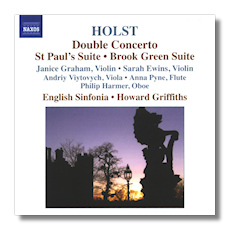
The Internet's Premier Classical Music Source
Related Links
- Holst Reviews
- Latest Reviews
- More Reviews
-
By Composer
-
Collections
DVD & Blu-ray
Books
Concert Reviews
Articles/Interviews
Software
Audio
Search Amazon
Recommended Links
Site News
 CD Review
CD Review
Gustav Holst

- Brook Green Suite
- A Song of the Night 1
- St. Paul's Suite
- Lyric Movement for Viola & Chamber Orchestra 2
- A Fugal Concerto for Flute, Oboe & Strings 3
- Concerto for Two Violins & Orchestra 4
1,4 Janice Graham, violin
4 Sarah Ewins, violin
2 Andriy Viytovych, viola
3 Anna Pyne, flute
3 Philip Harmer, oboe
English Sinfonia/Howard Griffiths
Naxos 8.570339 DDD 61:33
Gustav Holst is not a one-work composer, although The Planets – not even very typical of his output, despite the suite's popularity – have outshone everything else. This CD provides an excellent opportunity to explore Holst's other works. Just don't expect anything here to sound similar to The Planets!
Holst kept a fairly low profile for most of his life. He spent many years teaching at St. Paul's Girls' School in Hammersmith, and both the Brook Green Suite (1934) and the St. Paul's Suite (1913) are dedicated to that institution, or to the pupils therein. Both were composed for string orchestra, although the Brook Green Suite also includes optional parts for flute, oboe, and clarinet – not used here. These works are tuneful and uncomplicated, and they often suggest English folk music, actually drawing upon some of them (both The Dargason and Greensleeves) in the last movement of the St. Paul's Suite. Holst and Ralph Vaughan Williams were closely connected, and these two suites sound as if they could have been the work of the latter composer instead.
Holst wrote a number of lovely short works for solo string instruments and orchestra. His Invocation for cello and orchestra (not included here, but it can be heard on a different Naxos CD) is gorgeous, and both the Song of the Night for violin and orchestra, and the Lyric Movement for viola and chamber orchestra are hardly less attractive. The latter, like the Brook Green Suite, was written at the very end of Holst's life when he was very sick. The Song of the Night, written in 1905, originally was intended to be a companion piece to the Invocation, composed a few years later. For some reason, it was not published until the 1980s. All three of these works are quietly rapturous, even ethereal, and reminiscent of the mood of "Venus" from The Planets, although the style is different.
The Fugal Concerto (1923) reflects Holst's thorough knowledge of counterpoint, although this is anything but an academic work. In fact, most listeners probably wouldn't even realize that they were listening to fugues, were it not for the title. Again, the music is very low-key, in what one might call a "pastoral-mysterious" vein. The unusual Double Concerto (1929) opens with a Scherzo, which is followed by a Lament in 5/4 time, and is concluded with Variations on a Ground, which again displays Holst's technical prowess, not least because the movement is in 7/4 time! These two works are fine examples of the art that conceals art. It is remarkable that the composer of The Planets was a composer of such subtlety.
Griffiths and the English Sinfonia don't have many competitors in this repertoire. There's a Chandos disc from the mid 1990s conducted by Richard Hickox that contains most of these works, and one from Koch International Classics, but they are about twice as expensive as the one reviewed here. Fortunately, there's nothing about those performances to make one regret that price difference, or the lack of competition. This is music that asks to be played with simplicity and honesty, and the present performers do not weigh it down or seek to impose too much "interpretation" on it; it speaks for itself. The playing is on a high level, and the soloists all are members or former members of the English Sinfonia, so there's a strong collaborative feeling in the concertante works. The engineering is warm and sufficiently detailed, and Keith Anderson's notes do a good job of telling you what you want to know. There's no reason not to try this disc, if the repertoire interests you even slightly.
Copyright © 2007, Raymond Tuttle




















